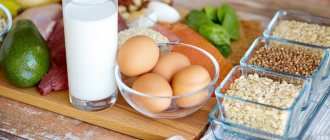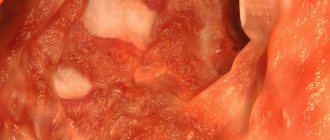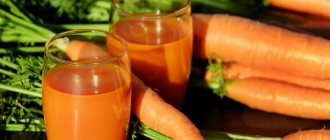- Basic rules for a healthy diet for constipation
- Recommended products for constipation and irregular bowel movements
- Harmful foods for irregular bowel movements and constipation
- Diet for bowel dysfunction and constipation
- Help during constipation
Such unpleasant symptoms as discomfort, a feeling of heaviness, flatulence, irritation and a general deterioration in well-being are just the tip of the iceberg called “constipation”.
When a person has serious bowel retention, it becomes almost impossible to think about anything else, and only one desire arises - to solve the problem as soon as possible. Everyone knows what constipation is, but there is an official definition. Constipation is a condition in which the frequency of bowel movements is less than three times a week. The stool is hard and there is a feeling of fullness1. Some doctors may diagnose constipation if there is no bowel movement within 48 hours. If there is no stool for less than 48 hours, then we can only talk about its delay1. The main cause of constipation is the slow movement of contents inside the intestines2.
The main task of dietary nutrition for constipation is to establish the natural process of intestinal function and restore its motility. In this case, food should be rich in all the elements and vitamins necessary for the body. Be sure to maintain water balance3.
The importance of a balanced diet
A balanced diet allows you to normalize the functioning of the gastrointestinal tract and control weight. Many experts recommend diet No. 3 for constipation. It is aimed at normalizing intestinal functions and metabolic processes in the body. A diet for constipation and bloating involves eating food at least 4 times a day. In this case, the daily amount of food should not exceed three kilograms. You need to drink at least 1.5 liters of fluid per day. Breakfast, lunch, afternoon snack and dinner should include healthy foods that contain proportional amounts of fats, proteins and carbohydrates. It is advisable to minimize the consumption of sugar and salt.
Up to contents
Kiwi
The weight of an average-sized kiwi is 75 g. This amount of pulp contains about 2.3 g of fiber, which allows you to cover about 9% of the body’s daily needs.
Scientists conducted an experiment. Its participants consumed a kiwi-based supplement for 4 weeks. It was possible to establish that their acts of defecation became more frequent in comparison with the control group [7].
Another study involving 11 subjects also examined the effects of kiwi on the gastrointestinal tract. They ate this fruit daily for 14 days. As a result, their stool became less hard and passed much more easily. [8]
The third experiment was carried out in 2010. It involved 54 people suffering from IBS. Their daily diet included kiwi, which they received for 28 days. All participants, without exception, noted an increase in stool frequency and its painless and easy passage through the intestines [9].
Scientists are of the opinion that kiwi helps relieve constipation thanks to actinidin. It is this enzyme that allows the product to activate intestinal motility and normalize stool [10], [11], [12].
To get the maximum benefit from kiwi, it must be eaten fresh, peeled. The pulp of the fruit is an excellent addition to any salad; you can make smoothies from it, which allows you to diversify your diet.
What can you eat and what can you not eat if you have constipation?
An approximate diet is prepared by a specialist and may include the following list of permitted foods:
| bread made from wholemeal wheat or rye flour | lean meat and fish, seafood (boiled or baked) | vegetables (beets, cabbage, carrots, tomatoes, sauerkraut, pumpkin, etc.) | berries (red rowan, lingonberry, gooseberry, blueberry, etc.) | honey and jam |
| vegetable non-rich soups | porridge with water (wheat, buckwheat, oatmeal) | low-fat dairy and fermented milk products (cottage cheese, milk, sour cream, fermented baked milk, etc.) | eggs (soft-boiled, in the form of an omelet) | vinaigrettes with vegetable oil |
| fruit compotes and decoctions of dried fruits, rose hips, wheat bran | herbs (celery, parsley, dill) | fruits (plum, apricot, melon, fig, etc.), both fresh and dried (prunes, dried apricots, etc.) | vegetable oils |
Prohibited products include:
| fresh white bread, bakery products from butter and puff pastry | “astringent” fruits (quince, pears, blueberries, pomegranate, lingonberries, dogwood) | soups made from rich and fatty broths | fatty dairy and fermented milk products | savory snacks |
| high fat dairy products | legumes | some drinks (coffee, cocoa, alcohol, strong tea, jelly) | hot seasonings (horseradish, pepper, mustard) | mushrooms |
| flour dishes (dumplings, dumplings, pies) | fatty meats and fish | vegetables that cause fermentation in the intestines (onions, radishes, turnips, garlic) | canned food | fried eggs |
| confectionery with rich cream | slimy porridges (rice, semolina) | some sweets (cakes, jellies, pastries, marmalade, chocolate, marshmallows) | smoked meats | mayonnaise, sauces |
Up to contents
Sample menu
The basic rule of diet is that 80% of the daily diet should consist of fiber. Berries, greens, fresh vegetables, bran - these foods contain a lot of fiber for constipation. We will have to completely abandon semi-finished products and fast food. They contain various additives that negatively affect not only the state of the gastrointestinal tract, but also the entire body as a whole.
- Breakfast
: porridge with milk. You can choose oatmeal, buckwheat or wheat groats. To improve the taste, it is possible to add dried fruits or raisins, previously soaked in boiling water. You should drink the porridge with herbal tea. - Second breakfast
: any permitted fermented milk product. It could be kefir, yogurt. - Lunch
: chicken, vegetable or fish soup. You can complement the dish with stewed cabbage or cabbage rolls. A few pieces of black “yesterday’s” bread, compote or herbal tea are allowed. - Afternoon snack: tea with unsweetened crackers. A mixture of permitted dried fruits is also suitable.
- Dinner
: steamed cutlets and buckwheat porridge. The main dish is complemented by a vegetable salad, well seasoned with vegetable oil.
By adhering to such a menu, you can normalize your stool within a week. In addition, nutrition helps improve peristalsis. Older people quickly return to their normal rhythm of life.
Cooking methods and temperature conditions
As part of the diet for constipation, boiled and steamed foods are prescribed. You can also eat dishes baked in foil (without crust). For atonic constipation, food should be prepared in portions and not crushed. This helps enhance intestinal motility. It is recommended to exclude purees and minced meat dishes. This is due to the fact that these products do not stimulate intestinal motility. With spastic constipation in the elderly, on the contrary, food should be very soft so as not to provoke abdominal pain. The diet requires compliance with the temperature regime: you should eat food heated to 15–60 °C. Too hot or cold foods can irritate the stomach, and this, in turn, will negatively affect intestinal function.
Up to contents
The main causes of constipation in older people
Problems with bowel movements are quite common among older people. Such difficulties with stool can last from 1 to 3 days. It is safe to say that 50% of older people suffer from constipation. According to experts, such disorders are most often provoked by an incorrect lifestyle. For this reason, older people should pay due attention to their daily routine and carefully consider the menu.
Constipation is often caused by insufficient water intake. This leads to severe hardening of the stool. In this case, the process of defecation becomes not only painful, but also almost impossible.
We must not forget about medications that older people take in large quantities. Often, drug treatment causes constipation. From this point of view, painkillers, diuretics and medications that relieve spasms are considered dangerous.
In addition, it makes sense to think about the performance of the body. Over the years, it has steadily fallen, and difficulties with bowel movements in older people in most cases arise against this background. Constipation can also be a concomitant factor for the following diseases:
- mental;
- disturbances in the functioning of the endocrine system;
- diabetes mellitus;
- atherosclerosis;
- constant stress and nervous tension.
In addition to all of the above, it is necessary to remember about the characteristics of the body of an elderly person. Over the years, all internal organs function intermittently, which causes deterioration of intestinal motility:
- The sensitivity of receptors located in the rectum decreases. This negatively affects the reflex that regulates the urge to defecate.
- The sensitivity of the rectum decreases, which leads to weakening of the muscles. This is often why older people sometimes fail to feel the urge to have a bowel movement in a timely manner.
- Low physical activity negatively affects the functioning of the intestines, which lose tone and muscle strength. Therefore, even in a relatively short period of time, the rectum can become filled with feces. Regardless of age, physical activity becomes one of the most important components of the treatment of constipation.
- Due to the progression of severe diseases in older people, blood vessels located in the abdominal cavity and pelvic organs may begin to be affected.
- If the intestines are not supplied with blood flow in the required quantity, its functional activity changes significantly. This, in turn, increases the likelihood of constipation.
If constipation occurs frequently, a concomitant disease develops - hemorrhoids. These two problems happen to every patient if he does not begin to treat the symptoms that appear in a timely manner. With any changes in the functioning of the intestinal tract organs, disturbances in bowel movements appear, and this over time causes the formation of hemorrhoids in older people. To prevent constipation from becoming chronic, it is necessary to start treatment on time and try to adhere to a certain menu.
We recommend
“Swelling in the elderly: causes, treatment, medications” Read more
Diet for adults with spastic constipation
Spastic constipation occurs due to spasms in the intestines that prevent the excretion of feces. To eliminate this condition, it is recommended to eat minced meat, boiled fish, low-fat cheese, honey, olive oil, pasta, jam, vegetable puree, strawberries, grapes, figs, plums, melons, pears, oranges, tangerines. Lamb and beef, mayonnaise, smoked cheese, pastries, chocolate, sauces, cakes, salami and white bread should be excluded from the diet.
Sample menu for day No. 1
| Breakfast | a glass of low-fat milk, rye toast with honey and butter. |
| Lunch | a glass of apricot nectar and 2-3 cookies. |
| Dinner | creamy zucchini soup, chicken with spinach, brown bread, some fresh fruit. |
| Afternoon snack | 300 g prunes. |
| Dinner | a portion of carrot puree and 2 cutlets. |
Sample menu for day No. 2
| Breakfast | 1 bunch of grapes, St. John's wort decoction with honey. |
| Dinner | stewed eggplants with tomatoes, boiled fish, rye toast, some strawberries. |
| Afternoon snack | 2 cookies and a couple of spoons of jam |
| Dinner | pumpkin puree and rosehip infusion. |
Sample menu for day No. 3
| Breakfast | grape juice with wholemeal toast, butter and jam. |
| Dinner | chicken soup, pumpkin or mashed potatoes with chicken. |
| Afternoon snack | 300 g prunes. |
| Dinner | a glass of apricot nectar and an omelette with vegetables. |
Up to contents
Citrus
For constipation, it is useful to eat oranges, tangerines and grapefruits. The advantage of citrus fruits is that they are not only rich in fiber, but also very tasty.
One orange weighing about 10 g contains 3.7 g of dietary fiber, which is 15% of the daily requirement of an adult. A grapefruit weighing 300 g will supply the body with at least 5 g of fiber, covering 20% of the daily requirement.
Citrus fruits contain pectin, a soluble dietary fiber. There is especially a lot of it in the peel. Passing through the intestines, pectin helps eliminate constipation. Another substance from citrus fruits is flavanol (naringenin), which helps soften stool and make bowel movements easier.
Naringenin has been shown to have laxative effects in animal studies. Under its influence, more fluid enters the intestines, due to which the contents come out more easily [15], [16]
Fresh fruits are considered the healthiest. After heat treatment, they lose some of their vitamin C, although the fiber remains intact. Citrus fruits are convenient to use as a snack, as they do not cause a feeling of heaviness, are easily digestible and have low calorie content.
Diet for children and adults with atonic constipation
To normalize bowel movements, you need to regularly eat foods high in fiber, as well as consume enough fats to help contract the intestinal walls. Compared to the diet for spastic constipation, the diet for atonic constipation is less gentle.
The diet for bowel disease with constipation usually includes raw fruits and vegetables. They are rich in ballast substances such as cellulose and fiber. These substances adsorb water and irritate the intestinal nerve receptors, which, in turn, helps normalize peristalsis.
Sample menu for day No. 1
| Breakfast | vinaigrette with low-fat sour cream, a portion of boiled poultry, weak tea. |
| Dinner | cold beetroot soup, boiled or baked chicken with pearl barley porridge, some figs. |
| Afternoon snack | a glass of rosehip infusion, bran bread and a couple of teaspoons of honey. |
| Dinner | boiled fish with vegetable stew, one baked apple. |
Sample menu for day No. 2
| Breakfast | weak green tea, sandwiches with lean ham, cucumbers and tomatoes. |
| Dinner | tomato soup with brown rice and parsley, boiled turkey with fresh vegetables, a glass of freshly squeezed apple juice. |
| Afternoon snack | a few apricots, a couple of tablespoons of raisins, low-fat yogurt |
| Dinner | salad with egg, green beans and tomatoes, rosehip infusion. |
Sample menu for day No. 3
| Breakfast | oatmeal with water, tea with milk, toast with low-fat cheese. |
| Dinner | pureed cauliflower soup, low-fat baked fish, freshly squeezed carrot juice. |
| Afternoon snack | some figs, dried apricots and prunes. |
| Dinner | stewed vegetables, boiled turkey, flax seed decoction, apple. |
Up to contents
Rhubarb
Rhubarb is a popular remedy for constipation. When passing through the gastrointestinal tract, the plant stimulates intestinal contractility. Its roots contain sennoside A (senna). It is well known as a laxative. [22], [23].
In an experiment involving rats, it was proven that sennoside A, extracted from rhubarb, reduces the amount of aquaporin 3. This protein is responsible for controlling the movement of water in the intestines, which is very important for constipation [24].
The lower the level of aquaporin 3, the less water will be absorbed from the intestines, which means the stool will become softer and easier to pass.
A 122g serving of rhubarb contains 2.2g of fiber. This amount covers the body’s daily requirement by 9%.
You should eat rhubarb stems, which are boiled and added to soups, baked goods, salads, and oatmeal. Including the plant in the diet allows you to enrich the menu with dietary fiber and stabilize the stool.
Diet for chronic constipation
A diet for chronic constipation is an individual diet that includes the consumption of a large number of healthy foods that have a beneficial effect on a person’s health and promote the natural process of bowel movements. The list includes dried and fresh fruits, raw vegetables. Doctors advise including apricots, prunes, figs, freshly squeezed vegetable and fruit purees, as well as juices in your diet for constipation. It is advisable to eat them at least 4 times a week. Porridges made from gray and dark-colored grains (buckwheat, oats, barley) are healthy. They need to be cooked in water with the addition of a small amount of vegetable oil.
Sample menu for day No. 1
| Breakfast | low-fat cottage cheese, milk, sandwich with ham and tomato. |
| Dinner | borscht, boiled veal with baked vegetables, several apricots. |
| Afternoon snack | rosehip decoction with rowan jam, a couple of cookies. |
| Dinner | boiled fish , a couple of baked potatoes. |
Sample menu for day No. 2
| Breakfast | freshly squeezed carrot juice, egg white omelette. |
| Dinner | vegetable soup, mashed boiled beets with vegetable oil, wholemeal rye flour bread. |
| Afternoon snack | a glass of fermented baked milk and several loaves of wholemeal wheat flour. |
| Dinner | baked beef, fresh carrot salad with vegetable oil, baked potatoes. |
Sample menu for day No. 3
| Breakfast | beetroot soup, boiled brown rice, baked low-fat fish. |
| Dinner | beetroot soup, boiled brown rice, baked low-fat fish. |
| Afternoon snack | some dried fruits and freshly squeezed fruit juice. |
| Dinner | vegetable casserole, baked chicken breast. |
Up to contents
Sweet Potatoes
Sweet potatoes are rich in fiber, which means they can be considered an effective remedy for constipation. One tuber weighing about 150 g contains 3.6 g of dietary fiber, which is represented by lignin and cellulose. The soluble fiber in sweet potatoes is pectin.
Coarse fiber stimulates the intestines, activates its motility and provokes the act of defecation. One study examined the effects of sweet potatoes on the gastrointestinal tract of patients undergoing chemotherapy. It is known that such treatment very often causes constipation. After just 4 days of regular consumption of sweet potatoes in an amount of 200 g, the participants’ gastrointestinal function normalized, and the symptoms of constipation became less pronounced [25].
Sweet potatoes are delicious and healthy in any form. It is boiled, steamed, and pureed. It helps to diversify your diet and improve the functioning of your digestive system.
Consequences of not following the diet
Failure to follow the diet prescribed by your doctor as part of the treatment of frequent constipation can lead to complications, such as:
- megacolon (dilated and elongated intestine);
- chronic inflammation of the colon;
- intestinal obstruction;
- diseases of the rectum (fissures, hemorrhoids, paraproctitis);
- malignant tumors in the intestines.
Up to contents
The information in this article is for reference only and does not replace professional advice from a doctor. To make a diagnosis and prescribe treatment, consult a qualified specialist.
1 V.F. Privorotsky, N.E. Luppova. Modern approaches to the treatment of functional constipation in children // RZHGGK. – 2009. – T.19. – No. 1. – P.59–65.
Legumes
Beans, lentils and peas are high in fiber. This group of products does not strain the budget, while at the same time bringing maximum benefits.
A 180g serving of beans contains 19.1g of dietary fibre. This amount of fiber allows you to cover 76% of the daily requirement of an adult in one meal.
100 g of boiled lentils contain 7.8 g of fiber. In terms of daily needs, this is 31%.
Legumes contain both coarse dietary fiber and soluble fiber. Its benefits for the gastrointestinal tract are difficult to overestimate. It not only softens stool, but also facilitates their passage through the intestines, helping to get rid of constipation.
You can make delicious soups with lentils, beans and peas, boil them, add them to salads and minced meat.
Doctors' opinion
It turns out that such a common problem among modern humanity as constipation does not always require drug treatment. As a rule, it is a consequence of errors in nutrition, an inactive lifestyle, and some age-related changes. If the disorder is chronic, a person cannot take pills throughout his life. Therefore, a universal solution for all people in this matter is appropriate nutrition. A healthy diet has a positive effect not only on the state of the gastrointestinal tract, but also on the entire body as a whole.











